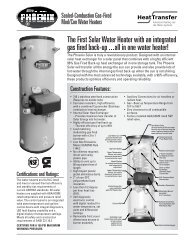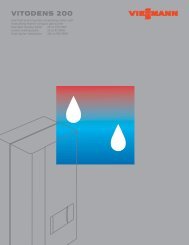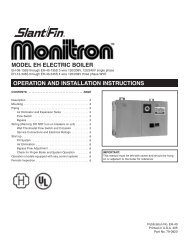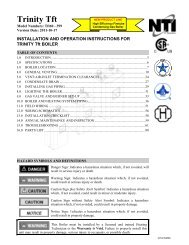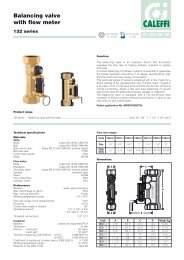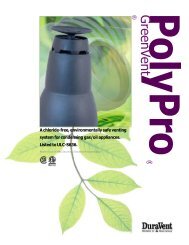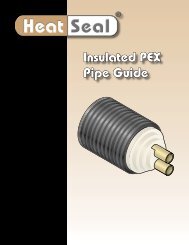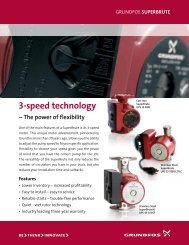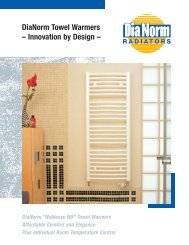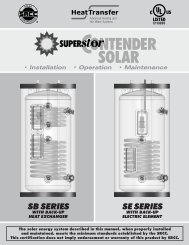Apricus Solar Water Heating System Installation and Operation ...
Apricus Solar Water Heating System Installation and Operation ...
Apricus Solar Water Heating System Installation and Operation ...
You also want an ePaper? Increase the reach of your titles
YUMPU automatically turns print PDFs into web optimized ePapers that Google loves.
<strong>Apricus</strong> <strong>Solar</strong> Collector <strong>Installation</strong> & <strong>Operation</strong> Manual - USA6.3. Sensors6.3.1. Sensor Informationa) The <strong>Apricus</strong> controller comes pre-wired for power <strong>and</strong> control of the Grundfos pump. All sensor wiresmust be installed manually. The controller is able to read up to 5 temperature sensors as well as data fromdigital flow meters.The most common positions for the sensors are as follows:Sensor 1 (T1): CollectorSensor 2 (T2): Bottom of the tankSensor 3 (T3): Between " <strong>and</strong> halfway down from top of tankCorrect sensor locations for various system configurations are presented in the system diagrams in the<strong>Apricus</strong> OG300 <strong>System</strong>s Manual.b) The <strong>Apricus</strong> controller utilizes PT1000 type sensors (thermistors) that have no polarity.c) Sensors should not be fully immersed in water.d) Sensors should be coated with silicone thermal paste to aid heat transfer.e) Protect Sensor Wires: Sensor wires should not be exposed to sunlight <strong>and</strong> must be protected fromcontact with sharp metal edges that could cut the wire or through its insulation. This is especially importantwhen pulling the T1 wire through the roof space. The collector sensor wire must not be run underneath theinsulation against the metal pipe as high temperatures will interfere with accurate readings to the controller<strong>and</strong> can damage the wire.6.3.2. Temperature Sensor <strong>Installation</strong> - Collectora) Sensor Well Location: The temperature should be measured at the hottest point in the collector: theoutlet of the collector manifold or the outlet of the last collector manifold in a series. There is a temperaturesensor well next to both plumbing ports on the collector. This allows whichever port is most convenient forthe particular installation to be chosen as the outlet.b) Sensor Insertion: The solar controller’s temperature sensor should be coated with a thin layer of heattransfer paste (same as is used on the heat pipe bulbs) <strong>and</strong> inserted into the sensor well to the full depth.The fit may be a bit loose.c) <strong>Water</strong> Ingress: Use a silicone sealant to prevent water ingress <strong>and</strong> to help secure the sensor inside thewell.d) High Temperatures: Ensure that sensors <strong>and</strong>, in particular, the sensor wire used on the collector arehigh temperature rated 395°F (200°C). Make sure that the wire can also be used in an exterior environment.e) Sensor Wire:i) Do not run the wire directly against the metal pipe as the wire may be damaged, instead run outsidethe insulation.ii) Do not run the wire inside conduit with electrical cables (check local electrical code).iii) Use cable ties (11”cable ties fit nicely around 3/4” pipe with 3/4” wall insulation) to secure at regularintervals. Avoid loose, drooping wire, keep it close to the insulation.iv) Some line-sets include a wire beneath the outer wrap. This should be connected to the sensor wirewith good quality, watertight soldered or plug connection. There are weather-resistant connectorsavailable with a silicone crush pack inside, these are ideal.v) The wire can be extended up to 60’ (20 m) using appropriately rated 18/2 thermostat wire. Forlonger distances, thicker gauge wire may be needed. After installing sensors with long extensions,check to ensure accurate temperature readings are being provided. The easiest way to do this is tohave a cup of cold water <strong>and</strong> a cup of hot water along with a h<strong>and</strong> held digital thermometer; simplycompare the readings from the sensor on the controller to the h<strong>and</strong> held readings.vi) Ensure the wire is not able to rub against any surfaces that could cause wear or cut the casing.Poor sensor readings are often caused by electrical interference with the wire or exposed wiring shortsetc.Copyright 2011 – <strong>Apricus</strong> Inc Doc: A7-05.4.1.4-PB-1.9 Page 54 of 126



